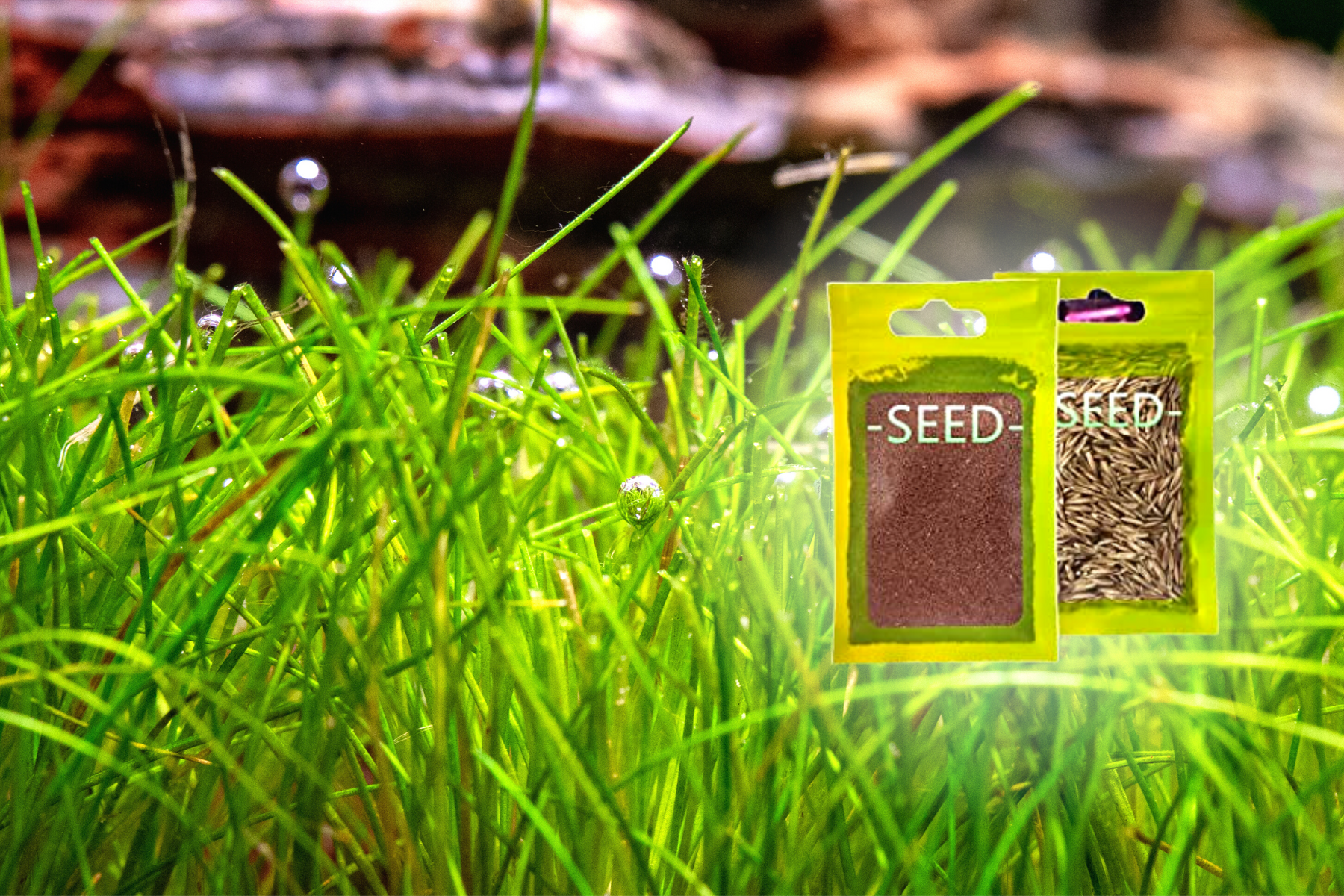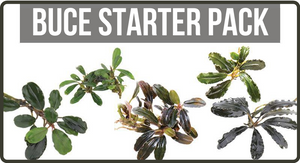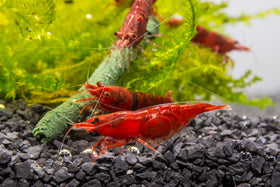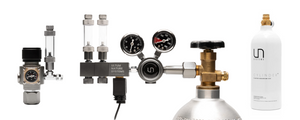
So-Called "Magic Seeds" and The Carpet Seed Scam
Written by: Tammy (@aquarist_tl) and Team Buce Plant
Have you ever seen carpeting plant seeds for aquariums being advertised online? If so, be cautious of spending your money on these "magic seeds." Unfortunately, they are more than likely falsely advertised products. Although they seem like a cheap and easy shortcut to getting a beautiful, carpeted aquarium, these seeds are likely to turn your aquarium into a mess in the long run.
In this article, we’ll discuss reasons why you should stay away from these aquatic carpet seeds, and tips on how you can properly grow a carpet in your aquarium.

What Makes These "Magic Seeds" So Tempting?
Having a lush carpet in a planted aquarium is the goal for many aquascapers. This is especially the case for a lot of newcomers, as seeing a beautifully carpeted scape may have been their reason for getting into the art of aquascaping.
Unfortunately, it’s easier for those that are newer in the hobby to fall victim to scams because they have less knowledge of aquatic plants and how to properly grow/propagate them. They see the potential to have a carpet of plants in their tank at a cheaper price rather than buying real plants and waiting for them to spread.
Knowingly, a magic carpet seed aquarium is usually marketed online as the "easier" way to a lush carpet, as opposed to the somewhat lengthy process executed by experienced aquascapers.

Are Carpet Seeds a Scam?
In a lot of cases, it may seem like carpet seeds are not a scam because the seeds grow plants that cover the area after a few days of being planted. However, as time goes on, the plants either begin dying off or change their appearance. Why? Because they are most likely seeds of some sort of weed, stem plant, or a plant that ultimately will not survive underwater.
These magic seeds are not the seeds of the traditional carpeting plants, like Hemianthus Callitrichoides or Dwarf Hairgrass, that are usually used in aquascaping. In fact, many aquascapers have grown these seeds out and found out they are from various types of plants, such as Oxalis corymbosa, Trichodesma calycosum, and even Ocimum tenuiflorum (otherwise known as Holy basil).
It's important to note that it's possible to grow some aquatic plants from seeds, like Glossostigma elatinoides. However, propagation for carpet plants is quicker through runners of the plant, which makes this method far more profitable for traders than collecting seeds from them. The work needed to collect aquatic carpeting plant seeds simply would not pay off.
Instead, these so-called carpet seeds are obtained from fast-growing plants that are typically some type of garden weed. They will survive for only short periods of time underwater, but the growth will look similar enough to carpet plants used in the aquascaping hobby today. Because of this, untrustworthy sellers will market them as "Magic Seeds," or the solution for a quick and easy aquarium carpet.
Why You Should Avoid Magic Carpet Seeds
Unfortunately, if the plants from these seeds are not true aquatic plants, then they will eventually start to die in the aquarium. These dying plants will rot in your tank and cause ammonia and nitrate levels will spike, potentially harming any livestock and crashing your cycle in your fish tank. Also, once the balance of the aquarium is thrown off, this can result in algae taking over. In the end, you'll have to thoroughly clean the tank and remove the seeds. Worst-case scenario: you'll have to tear down the tank and start from scratch.
On the other hand, if the plants start to change in appearance, (e.g. the leaves become bigger or the stems become longer), then they’re probably seeds for stem plants. It is also possible that they are a plant that's considered a weed, meaning they grow and propagate very fast and are difficult to get rid of. It may be too hard to completely clear the aquarium of this plant once it’s been planted so thoroughly in it, so hobbyists sometimes end up having to restart the whole aquarium.
At the end of the day, these seeds will most likely leave you with a big mess to clean. It may even result in the necessary teardown of the tank, causing a serious loss in money and a waste of efforts.
To show examples, here are a few real reviews from Amazon customers who purchased carpet seeds and shared their experiences:

Quick Tips for Growing Carpet Plants the Right Way
Instead of using seeds, you should consider purchasing plants from a trusted aquarium source. Although it can take time to create that lush foreground you're hoping for, it is always worth the wait. Here are some recommendations to help get started on your carpet:
1. Try the Dry Start Method
One of the best ways to get your carpet plants to thrive is with the Dry Start Method (DSM). Basically, the concept of this strategy is to allow the plants to grow emersed (out of water) for a while so they have an abundance of CO2 to aid in their growth. This will allow the plants to get a head start before beginning their life underwater. Most of the aquatic plants we use in our aquariums are able to grow both submerged and emersed, but they have a much easier time growing above water than under.
Many experienced planted-tank hobbyists will choose tissue culture carpeting plants because they are completely sterile and each cup comes with a lot of plantlets. However, the Dry Start Method also works with potted plants. Simply split the plant into multiple plantlets and plant densely throughout the substrate. Then, thoroughly mist all of the plants 2-3 times a day and keep it covered with plastic wrap to conceal the moisture in the tank.
Make sure to leave your aquarium light on for about 8 hours a day during the DSM. They repeat this process daily for about 4-6 weeks before flooding, or until you're satisfied with the growth. By this time, the plants will have established themselves and will continue to spread throughout the substrate after the flood.
- Want to learn more? Click here for a step-by-step guide to the Dry Start Method.

New UNS 5N scape using the Dry Start Method
2. Utilize CO2 Injection
Injecting carbon dioxide (CO2) into the aquarium will help the plants grow dramatically faster than without. If you go the low-tech route, then the plants may take a long while before they can cover the area around them to provide that nice carpet-look. Admittingly, CO2 will expand the number of plant options you can keep that may be more difficult to grow under low-tech setups.
3. Provide a Nutrient-Rich Substrate
Carpeting plants will need all the nutrients they can get. It's important to provide them with the necessary nutrients they need via the substrate you plant them in. So, a substrate like Controsoil that is designed to enhance plant growth would greatly help get your carpet going instead of those that lack any nutrients like gravel or sand. Make sure to plant each plantlet deep enough into the substrate using pinsettes to prevent any floaters while the plants establish.

Conclusion - Magic Seeds or Live Plants?
Hopefully, this provides insight as to why these so-called "Magic Seeds" are not the best choice for your aquarium. These seeds are highly unlikely to be what they are marketed as and will likely melt away in your aquarium sooner or later. While the "instant carpet" they promise for your aquascape is tempting, it's best to consider investing your time and money in high-quality plants and in growing a carpet the traditional way instead. To explore live carpeting plant options and get started, you can click here.
If you would like more information on how to properly grow aquarium carpet plants, you can find more tips here, or reach out to Team Buce Plant with any questions you have!
Hopefully, this information is able to help out anyone looking to grow a carpet plant for their aquascape. Happy scaping!
Tell us - Was this article helpful? Please leave a comment below!
If you have any questions regarding this article, please DM us on Instagram, Facebook, or email support@buceplant.com so we can assist you - @buceplant





Comments
Leave a comment